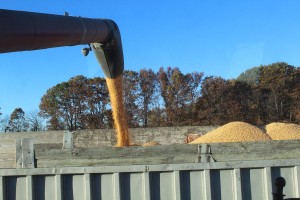WOOSTER, Ohio — Mostly dry conditions the past few days and for the week ahead have farmers in Ohio and western Pennsylvania slowly returning to the fields.
Slowly — because many fields are still wet, and the crop moisture is still high, especially for corn.
Holmes County farmer Jim Croskey took advantage of a mild afternoon Oct. 24 to harvest beans in a gravely field near Holmesville that had dried out ahead of the others.
Croskey figured he had harvested about 30 acres of beans, with nearly 200 to go. Like other area farmers, the wet spring set planting back a few weeks, and now harvest is late, as well.
On the bright side, the crop is looking good, with above-average yields.
“The late rain that we got really helped the yield,” he said. “If we can keep some dry weather, it should be a good harvest.”
Strong yields
According to the National Agricultural Statistics Service, the U.S. corn harvest is projected at a record 14.5 billion bushels, up 4 percent from last year. National yields are expected to average 174.2 bushels per acre, a sizable (15.4 bushel) increase from last year.
On the same note, the U.S. soybean crop is expected to set a new record, at 47.1 bushels per acre, up 3.1 bushels from last year.
In Ohio, both corn and soybeans are on pace to set new yield records. Corn is projected at 178 bushels per acre, and soybeans are projected at 50 bushels per acre.
In Pennsylvania, corn yield is projected at 152 bushels per acre, and soybeans are projected at 50 bushels per acre.
When the beans are off, it will be time to harvest corn. Most farmers in the Farm and Dairy readership are still working on beans, but a few have made it into the corn.
Shelling corn

Ashland County grain farmer Jim Smith said he finished about 260 acres of beans, and is just getting started with corn.
He’s seeing corn moisture levels of about 24 percent — higher than he wants — but he’d rather get it off than chance
it to winter damage from the weather and mold.
According to NASS, as of Oct. 26, only 36 percent of the corn in Ohio is harvested, compared to the five-year average of 44. In Pennsylvania, 39 percent is harvested, compared to the five-year average of 49.
Winter wheat planting is also behind, with 72 percent planted in Ohio, compared to the five-year average of 80 percent. In Pennsylvania, 82 percent of winter wheat is planted, ahead of the five-year average of 73 percent.
Greater risk
The latest edition of Ohio State University Extension’s CORN Newsletter says the longer crops are left in the field, the greater the chance for rot and mold issues, as well as ear drop.
Their research shows that nearly 90 percent of the yield loss associated with delayed corn harvest occurred when delays extended beyond mid-November.
At the same time, leaving the crop in the fields to dry can save farmers’ money on drying it themselves — if the weather holds up.
According to OSU’s research, grain moisture decreased nearly 6 percent between harvest dates in October and November, while delaying harvest beyond early- to mid-November achieved almost no additional drying.
“It’s a balancing act,” Croskey said. “You never know when the next dry spell is going to come.”
The profit margins will be tight for many farmers this year, as prices are down considerably. Beans are selling for below $10 a bushel, and corn is ranging from slightly below, to slightly above $3 per bushel.
Meanwhile, input costs like seed, equipment and rent are all up.
“My biggest concern is am I going to make any money on it,” Smith said.
******
Delayed harvest pointers:
(Here are some key points that might affect how you go about the late harvest.)
• Ohio State University crop researchers conducted a study a few years ago that evaluated effects of four plant populations (24,000, 30,000, 36,000, and 42,000 plants/acre) and three harvest dates (early-mid October, November and December) on the agronomic performance of four hybrids differing in maturity and stalk quality.
The study was conducted at three locations in northwest, northeast, and southwest Ohio over a three-year period, for a total of eight experiments. The results provide some insight on yield losses and changes in grain moisture and stalk quality associated with delaying harvest:
• Results showed that nearly 90 percent of the yield loss associated with delayed corn harvest occurred when delays extended beyond mid-November.
• Grain moisture decreased nearly 6 percent between harvest dates in October and November delaying harvest after early to mid-November achieved almost no additional grain drying.
• Higher plant populations resulted in increased grain yields when harvest occurred in early to mid-October. Only when harvest was delayed until mid-November or later did yields decline at plant populations above 30,000/acre.
• Hybrids with lower stalk strength ratings exhibited greater stalk rot, lodging and yield loss when harvest was delayed. Early harvest of these hybrids eliminated this effect.
• The greatest increase in stalk rot incidence came between harvest dates in October and November. In contrast, stalk lodging increased most after early-mid November.
• Harvest delays had little or no effect on grain quality characteristics such as oil, protein, starch, and kernel breakage.
• In this study, yields averaged across experiments, populations and hybrids, decreased about 13 percent between the October and December harvest dates.
Most of the yield loss, about 11 percent, occurred after the early-mid November harvest date. In three of the eight experiments, yield losses between October and December harvest dates ranged from 21 to 24 percent. In the other five experiments, yield losses ranged from 5-12 percent.










